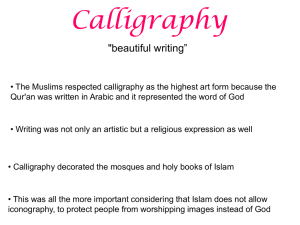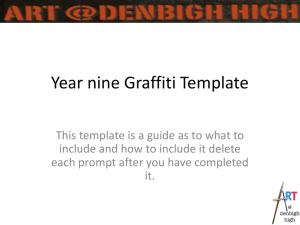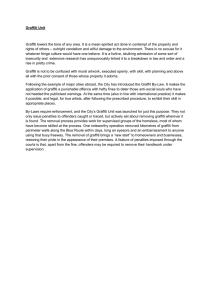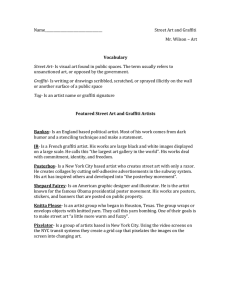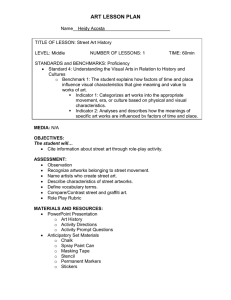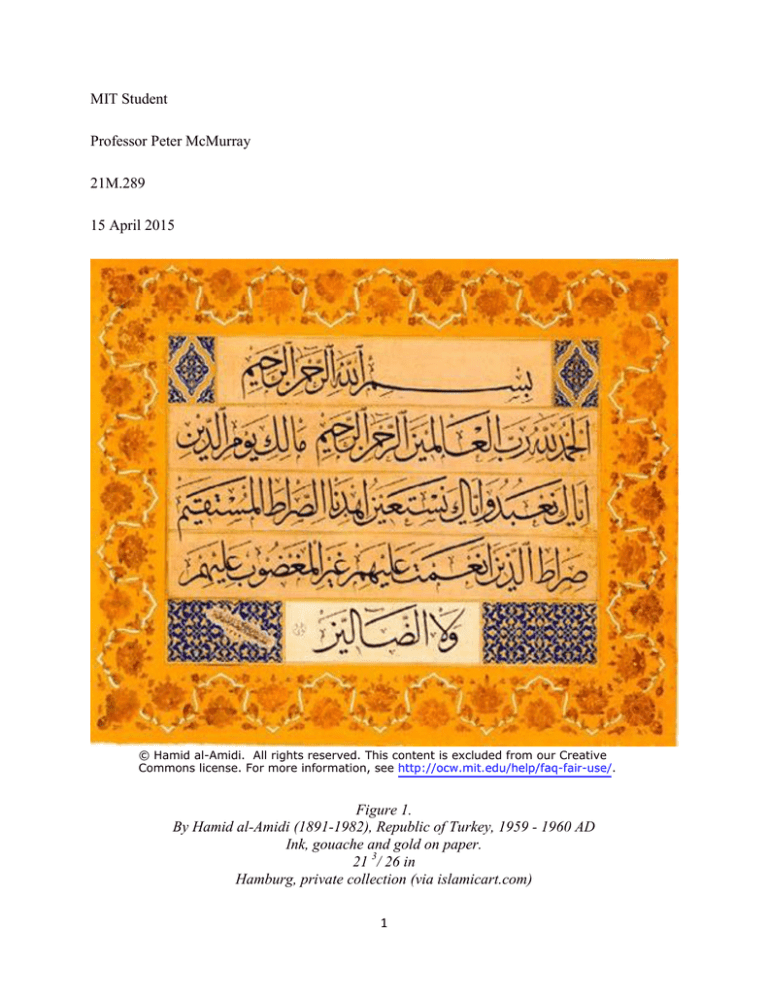
MIT Student
Professor Peter McMurray
21M.289
15 April 2015
© Hamid al-Amidi. All rights reserved. This content is excluded from our Creative
Commons license. For more information, see http://ocw.mit.edu/help/faq-fair-use/.
Figure 1.
By Hamid al-Amidi (1891-1982), Republic of Turkey, 1959 - 1960 AD
Ink, gouache and gold on paper.
21 3/ 26 in
Hamburg, private collection (via islamicart.com)
1
Project 2: Expanding Beyond the Text
“[The Quran’s] verses were written in the Arabic script, first by the Prophet’s associates
and later by professional scribes who tried to give reverent physical form to the immutable
beauty of God’s word” (Bloom).
Figure 1 is an image of a composition created by Hamid al-Amidi in the 20th century. The
translation of the Arabic text in Figure 1 is as follows:
"In the name of God, The Compassionate, The Merciful; Praise be to God; the Cherisher
and Sustainer of the Worlds; The Compassionate, The Merciful; Master of the Day of
Judgment. Thee do we worship, and thine aid do we seek. Show us the straight way; The
way of those on whom Thou hast bestowed Thy Grace, Those whose portion is not wrath,
And who go not astray" (islamicart.com)
This is the opening Surah of the Qur’an and one of the most familiar surahs for Muslims
(islamicart.com). The opening Surah is essential for daily prayers and will be memorized early
on in a Muslim’s spiritual journey. Since the Surah serves a vital function in the Islamic world,
the artistic piece (Figure 1) at a rudimentary level captures the significance of the Quran’s
message enfolded in the text. The information can be adequately enfolded into plain calligraphy
of the form of one color of ink on a blank piece of paper. This type of information storage can
be found throughout Islam civilizations as the writings of students learning the Quran or
calligraphy on buildings to communicate their function as holy spaces. Yet when Hamid alAmidi created his composition (Figure 1), he chose to go beyond the rudimentary and the result
is an image which attracts the eye and is sensually appealing. Perhaps the most fundamental
explanation for why he would choose to make this piece is to engage emotion as the observer
2
internalizes the opening Surah. Emotion intensifies as the piece progresses further away from its
roots in the plain calligraphy.
There are many attributes of the overall piece which can be explored, including the
position of different segments, the addition of decorative shapes, and the incorporation of
supplementary text. The enhancements to the ancient Quranic text in Figure 1 are comparable to
the artistic approach of modern day graffiti artists whose art is to enhance the enfolded
information within a word or message by means of additions to the basic text. As the artistic
features of this piece are elaborated on, it becomes clear artists of different styles and generations
employ similar ideas in order to elaborate on a core idea artistically.
In Figure 1, the calligraphy is centered and spaced neatly into rectangles. Because the
rectangles containing text seem to fit neatly into the spaces between the dominantly blue
rectangles and the gold decoration goes around the rest of the image as a border, the process for
creating this piece seems to have begun with the spaces containing writing and expanded
outward, with other elements being added sequentially. This is representative of the fact the
piece gains it’s significance from the message enfolded in the Arabic calligraphy. The rest of the
piece is developed from the calligraphy. When Hamid al-Amidi felt the piece was complete in
its intended purpose having reached sufficient development of the core idea, he concluded his
artistic work (islamicart.com). Just as al-Amidi used background color to accentuate different
parts of the message, graffiti art will often feature a background of clouds or bubble shapes to
differentiate the letters forming the graffiti piece from the canvas on which it is created (a wall or
a piece of paper). The background makes the letters stand out, as if elevating it out of the 2D
plane on which it exists in order to allow the observer to experience it in a more intimate way.
3
© Boksmati. All rights reserved. This content is excluded from our Creative Commons
license. For more information, see http://ocw.mit.edu/help/faq-fair-use/.
Figure 2.
From http://boksmati.blogspot.com/2008/03/arabic-graffiti-urban-arabic.html
This intimacy within the art is relatable for Muslims and graffiti artists alike. Islamic
faith is intensely intimate because of the nature of getting closer to God through faith, and for the
art to reflect this intimacy only enhances the experience of engaging with a passage of the Quran.
Similarly, the more time spent with a particular graffiti artist’s work, and the more immersed the
observer becomes in the name, symbol, character, or even style the artist consistently chooses to
employ in his/her work, the more intimately acquainted the observer becomes with the individual
behind the art. The identity of the artist is reflected in his/her work since the name he/she uses,
the choice of colors and characters, the location in which the artist does the graffiti will shed
4
light on their personality, the media they engage in (someone might add Sponge Bob to a graffiti
piece showing they are playful and enjoy cartoons), and the way the artist identifies
himself/herself geographically. Reading graffiti and appreciating its artistic elements forms an
intimacy between the observer and the artist. In addition to provoking intimacy and emotion, the
artist reveals an intention to share the piece with a larger audience through further artistic
expansion.
The images surrounding the calligraphy in al-Amidi’s work and the complexity of graffiti
pieces make it clear they are intended for display where they can be appreciated by multitudes.
The amount of time which is necessary to create either artistic composition is significant, and the
artist must have a motivation for adding decorative elements to the core text. Works focusing on
Quranic passages such as Figure 1 may differ from graffiti in that the key motivation may be the
glorification of God. By adding floral and geometric imagery, al-Amidi enhances the
calligraphy in a way which is pleasant and complimentary to the writing and yet the writing is
undisturbed. Intuition would suggest the Quranic verse is meant to be read based on its
legibility. A wide audience would be able to appreciate the message and find beauty in the piece
as a whole. On the other hand, graffiti pieces utilize decoration in a different manner.
The key intention of decorative elements in graffiti is not to immerse the observe deeper
in the experience of wrestling with the message. A majority of graffiti pieces professionally
crafted and labor-intensive abstract the text so much the original letters fade into the background
as subsidiary to the aesthetic of the decorations. Whereas every aspect of al-Amidi’s piece,
while elegantly decorated, lends itself to draw the observer back to the text – and in the text the
information enfolding the expansive realm which is faith – graffiti pieces often encourage the
5
viewer to look elsewhere, seeking meaning and purpose in the background imagery, characters,
arrows, three-dimensional enhancements, and more.
© TrainWriters.com. All rights reserved. This content is excluded from our Creative
Commons license. For more information, see http://ocw.mit.edu/help/faq-fair-use/.
Figure 3. (by Mr. Wiggles)
Figure 3 identifies many of the decorations which can be used to expand on the basic text
at the core of graffiti.
6
© TrainWriters.com. All rights reserved. This content is excluded from our Creative
Commons license. For more information, see http://ocw.mit.edu/help/faq-fair-use/.
Figure 4. (Mr. Wiggles)
Figure 4 shows how the artistic approach to writing graffiti often starts with the text and
expands outward into a complex piece. In both traditional Islamic art and contemporary graffiti,
the text is essential to the compositions and acts as the foundation of artistic expression.
Identity comes back into the discussion when considering the addition of the name found
on al-Amidi’s piece and the “signatures” which often accompany graffiti pieces. The signing of
7
an artistic piece by the artist should not be overlooked in Islamic art or graffiti. In modern days,
the signature is universally practiced. It is iconic for intentionally or unintentionally conveying
the artist’s deliberate decision to make this piece as a piece of art for display. Graffiti artists do
not sign pieces they have only half finished. Painters do not sign paintings until they have
completed the painting. Dating further back than al-Amidi’s days all the way to book binders
illuminating manuscripts in the Middle Ages, signing a piece has established two concepts. The
first is exposed in the following passage:
“With the gradual rise in status from artisan to artist, more illuminators in the late Middle
Ages began to sign their work, and often also included a small pictorial representation of
themselves somewhere in the work”
By signing the work, the artist is claiming their status as an artist. An artistic work
should be inspected with the understanding the elements were chosen intentionally to form the
whole. It is reasonable to argue the elements of Hamid’s text were included for a purpose and
neither the calligraphy or the geometric patterns or the boarder are sufficient in defining the
artistic work as a whole. The analog to this in graffiti is once a piece has been made which
incorporates letters, a cartoon character, and several arrows pointing out from the letters, no
single element is capable of representing the intention of the artist’s work when he/she crafted
the whole.
The second established idea is the way a signature signifies the finishing of the piece.
The universal practice of signing pieces of art is the unspoken declaration the piece is finished,
and it should be inspected as a finished piece rather than a something in progress. The finishing
of the piece is important because only upon completion does the observer acquire a transparent
window into the logic and emotions to characterize the piece as the artist intended.
8
The artistic expansion on calligraphy in Figure 1 takes the significance of the opening
Surah deeper into a rich expanse of emotion, identity, and completeness. The methods by which
al-Amidi achieves this fantastic work of Islamic art can be compared with the methods by which
contemporary graffiti artists are expanding upon text to create works of art. The Quran is a
reference point for beauty with its poetic writing style and message of good news for believers.
Art engages the mind and the heart both in large proportions, and art can be a meaningful way to
internalize important ideas of faith and identity. The potential impact of expanding on text
seems to be limited only by the creativity of the artist.
9
Works Cited
"Arabic Calligraphy." Islamic Arts and Architecture Organization. Web. 15 April. 2015.
"Arabic Calligraphy of The Holy Quran." Islam101.com. Web. 15 Apr. 2015.
Bloom, Jonathan, and Sheila Blair. "What Is Islamic Art?" Islamic Arts and Architecture. Web.
15 Apr. 2015.
Boksmati. “Boksmati Graphix.” Blogspot. Web. 15 Apr. 2015.
"Graffiti Letters." Trainwriters.com. Web. 15 Apr. 2015.
“History.” The Illuminated Page. Web. 15 Apr. 2015
Further Research was conducted through the following sources. In order to develop on the ideas
discussed here, I started by spending a couple of hours reading about the Arabic alphabet and
practices in writing calligraphy. I also watched videos from a lesson series on learning the
Arabic alphabet in order to become familiar with the letters, vowel usage, and connecting letters
together to form words. Further elaboration on the topics in this paper could involve the
discussion of artistic abstraction of the calligraphic text. Kufic script has a great deal of variety
and demonstrates the power of being familiar with words and ideas by presenting text which is
abstracted but still understandable.
Further sources not used for paper:
Arabic Alphabet:
http://www.islam101.com/quran/letters.html
10
About Arabic Calligraphy:
http://islamicart.com/main/calligraphy/intro.html
Source for Learning Alphabet by Video:
https://www.youtube.com/playlist?list=PL40BF34CE84F8BAC5
Calligraphic Styles:
https://www.claremontmckenna.edu/ml/The_Art_of_Arabic_Calligraphy.php
http://www.moroccancalligrapher.com/styles/
Naskh Script:
http://static1.squarespace.com/static/522d09abe4b0673919befd5e/522ff03fe4b08c58ebe7f199/52
2ff5d6e4b0c5d6fd6320e5/1378931985061/tammim%2B%2B.jpg
(Taken from Moroccan calligraphy site)
Quran Calligraphy:
https://www.google.com/search?q=quran+calligraphy&rlz=1C1LENN_enUS441US441&espv=2
&biw=1366&bih=667&source=lnms&tbm=isch&sa=X&ei=KtQqVZ2jMqfnsATNi4GA
CQ&ved=0CAYQ_AUoAQ
Allah Examples:
https://www.google.com/search?q=Gulzar&rlz=1C1LENN_enUS441US441&es_sm=93&source
=lnms&tbm=isch&sa=X&ei=FsYqVf3fJPWHsQSakYGIBg&ved=0CAkQ_AUoAw&bi
w=1366&bih=667#tbm=isch&q=allah+calligraphy
11
Kufic:
Kufic Shapes:
http://islamicart.com/main/calligraphy/styles/kufi.html
Kufic Quran page:
http://www.sothebys.com/en/auctions/ecatalogue/2012/arts-of-the-islamic-world/lot.401.html
Kufic Script “Bismillah”:
https://www.google.com/search?q=kufic+script+bismillah&rlz=1C1LENN_enUS441US441&es
pv=2&biw=1366&bih=667&source=lnms&tbm=isch&sa=X&ei=Ft0qVZSIAZCRsQSrtI
GYBQ&ved=0CAYQ_AUoAQ
Graffiti:
Arabic Graffiti, Lebanese Artist:
http://boksmati.blogspot.com/
Graffiti and Calligraphy in Tunisia:
http://www.bbc.com/news/world-africa-26515754#
Article about types of graffiti from tags to Pieces:
http://weburbanist.com/2009/10/01/graffiti-lettering-9-cool-characters-alphabets-fonts/
The way a word can be understood when the meaning is already known:
Gall, Frederik. "Easy To Read 1." Behance. Web. 15 Apr. 2015.
12
MIT OpenCourseWare
http://ocw.mit.edu
21M.289 Islam/Media
Spring 2015
For information about citing these materials or our Terms of Use, visit: http://ocw.mit.edu/terms.


